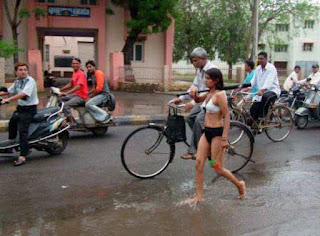Photograph of Sarah "Hottentot" Baartman from the 1800's
Photograph of Sarah "Hottentot" Baartman from the 1800's
Some accounts indicate that she had a relationship with a poor Dutch soldier, Hendrik van Jong, who lived in Hout Bay near Cape Town, but the relationship ended when his regiment departed. I wonder if her destiny might have been different had he stayed on or taken her with him. Africa is replete with stories, both past and present, of foreign men who come to seek adventure, fortune or take part in war and then, like predators, have fleeting empty relationships with African women. They leave behind a trail of emotional destruction and in some cases neglected children when they pack their bags and move on, abandoning the women.
In 1810, Baartman went to England under dodgy and exploitative circumstances with her 'owner' Cezar and an Englishman, William Dunlop. Their mission was to exploit and display her body for monetary gain, which they did at the Piccadilly building where she was duly nicknamed the "Hottentot Venus". As a typical Khoisan woman, she had unique physical features; honey brown skin, large hips, enlarged labial lips and large protruding buttocks. As curious Englishmen peered, gawked and gasped at her, I can only imagine the thoughts that flooded through her mind; was she afraid? Lonely? In tears? Resigned to her fate? Traumatized and home sick? It is recorded that she kept a small tortoise shell necklace, probably given to her by her mother, until her death. I think that was her connection to home and her happy space that she held onto during dark moments.
The great historical irony is that her 'protruding buttocks', which was an oddity at that time that saw her carted away across the ocean far away from home, is now in demand by modern entertainers and reality stars who pay good money to have surgery to achieve the same features. Perhaps the modern reality shows and music videos are the cages similar to the one Sara was paraded in but held together by money and vanity instead of iron.
SAHO further states that, "After four years in London, in September 1814, she was transported from England to France, and upon arrival Hendrik Cezar sold her to Reaux, a man who showcased animals. He exhibited her around Paris and reaped financial benefits from the public's fascination with Sara's body. He began exhibiting her in a cage alongside a baby rhinoceros". In Paris, her existence was miserable and extraordinarily poor. She was treated like an animal and some evidence suggests that at one point a collar was placed around her neck. It's disturbing that in modern times, a lot of charity organizations have been set up to fight rhinoceros poaching without the same effort and resources being poured into fighting racism and human sexual trafficking. The descendants of Baartman's companion in the Paris cage, the rhinoceros, still have a better deal.
Sara Baartman died in 1816 and various reasons have been attributed to her death including alcoholism, pneumonia, smallpox and syphilis. I postulate she just died of heartbreak, humiliation, loneliness and sorrow. After her death, SAHO state that "(George) Cuvier, a naturalist obtained her remains from local police and dissected her body. He made a plaster cast of her body, pickled her brain and genitals and placed them into jars which were placed on display at the Musée de l'Homme (Museum of Man) until 1974".
My mind struggles to reconcile with the brutality and sheer contempt exhibited towards Baartman. Her remains should have been taken home immediately upon her death or at least accorded a decent burial in Paris. Such brutality and hatred based on nothing but physical appearance and skin color has never left, it has just been suppressed and adorned in different sheepskin. The Musée de l'Homme (Museum of Man) benefited immensely by displaying Sara Baartman's remains for all those years. The decent thing for the museum to do would be to track down her family descendants and pay some kind of reparation or a make significant contribution to organizations that are fighting human sexual trafficking across the globeMemorial for Sarah Baartman of Hankey South Africa
After President Nelson Mandela took over power in 1994 ending the brutal apartheid regime, South Africa undertook the process of repatriating Baartman's remains back home. On 9 August 2002, Ssehura Sara 'Saartjie' Baartman was finally buried at Hankey in the Eastern Cape Province.
Her story is an isolated case in African history that was luckily recorded. There are plenty of lost sons and daughters out there; nameless, faceless and unburied with souls wandering the dark edges looking for a way home. They are victims of the tribal slave trade, the Arab slave trade, the colonial slave trade and internecine tribal wars. Besides people, artefacts, cultural heirlooms, religious symbols, and generations of wealth have also been lost to museums abroad and rogue collectors.
I leave you with a prayer from Sara Baartman's people, the Khoisan ~ "When the moon dies every month, let the sin in me die with it. When the moon is reborn each month, let the good in me be reborn with it.






Comments
Post a Comment